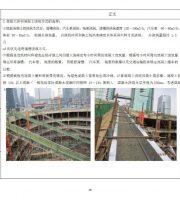(5) when there is ponding on the top of the foundation pit before the excavation of the foundation pit, it shall be removed in time; During construction, a water retaining sill shall be set 2m away from the foundation pit to prevent the ground water from flowing into the foundation pit.
During the construction, pay attention to the following construction requirements: ⑴ the rail pile is driven by crawler excavator (with vibrating hammer).
2.2.5.
2.1.1.
The utilization and support setting of the standard steel rail pile.
(2) The plane layout shape of the steel rail pile for the retaining wall of the foundation pit shall be as straight and tidy as possible to avoid irregular corners.
The lifting methods include bundle lifting and single lifting.
From the perspective of construction safety, cost saving and shortening the construction period, the general construction scheme of slope excavation is summarized as follows: 1 The plan dimension of the pile cap of the main pier of a double track super large bridge is 11.3m long, 6.3m wide and 7m deep.
Sleepers shall be placed between each layer, and the spacing of sleepers is generally 3-4m.
According to a project and considering the geological conditions of each bridge, the excavation depth of a pier foundation is up to 7m.
The construction of rail pile is related to the foundation pit support and safety, and is one of the most critical processes in the construction of the project.
Considering the specific conditions such as engineering geology, on-site operation environment, form, weight, length and total quantity of steel rail pile, the vibration hammer driving method is selected for the construction of this section.
Steel cables are usually used for bundle hoisting, while special lifting tools are commonly used for single hoisting.
The unqualified ones can be used only after finishing.
Steel rail piles shall be stacked on a flat and solid site that will not suffer from large settlement and deformation due to weight, and shall be transported to the piling construction site.
2.
During lifting, the number of steel rail piles lifted each time should not be too many.
(3) During the whole foundation construction period, it is strictly prohibited to collide with the support, dismantle the support arbitrarily, cut and weld arbitrarily on the support, and do not put heavy objects on the support during the construction operations such as excavation, hoisting, binding reinforcement and pouring concrete.
Taking the double track super large bridge 8# pier across Jiuli station of existing Chengdu Kunming Railway as an example, the construction scheme of rail support is introduced as follows: 2.1 The construction sequence of rail pile support is arranged as follows: rail pile reinforcement of existing line foundation slope → foundation pit excavation → cushion cap construction → pier column construction → cap beam support erection → cap beam construction → site cleaning.
(2) before pile driving, check the rail piles one by one, and remove the rail piles with serious deformation.
(5) the steel rail pile shall be driven one by one.
(2) determine the position of bearing platform according to the measurement (3) excavate in layers and avoid all possible dynamic loads.
The rail pile should be hoisted and loaded at two points.
(see the figure below) 1.1 Construction process flow of deep foundation pit cushion cap sloping excavation and support construction process flow: Measurement and setting out → safety protection → foundation pit excavation → setting up water collecting well and drainage ditch → foundation pit cleaning.
When the deviation is too large and cannot be adjusted by the leveling method, pull up and strike again.
(4) before foundation pit excavation, protective railings, protective nets, hazard signs and other protective measures shall be set around the pit top according to the edge protection.
General requirements for rail pile support construction (1) the setting position of rail pile shall meet the design requirements to facilitate the construction of bearing platform, that is, there is room for formwork support and removal outside the most prominent edge of the foundation.
(8) after the foundation pit is excavated, the loose soil at the bottom of the pit shall be removed manually, the convex and concave parts shall be removed, and the slope shall be corrected.
Inspection and correction of rail piles the finished rail piles used for foundation pit support are new products and can be inspected according to the factory standard; Before using the reused rail pile, the appearance quality shall be inspected, including whether the length, width, thickness and height meet the design requirements, whether there are surface defects, verticality, etc.
It is mainly shovel, and no filling is allowed.
When the excavation is close to the design pit bottom elevation, the base shall be left with a thickness of not less than 20cm and replaced by manual excavation to avoid disturbing the base soil layer during mechanical construction.
2.2.2.
During stacking, attention shall be paid to: 1) the sequence, location, direction and plane layout of stacking shall take into account the convenience of future construction; 2) Steel rail piles shall be stacked separately according to model, specification and length, and signs shall be set at the stacking place to explain; 3) Steel rail piles shall be stacked in layers, and the number of piles stacked in each layer shall generally not exceed 5.
(7) when the groundwater level is high and water seeps into the foundation pit, set up drainage ditches and water collecting wells around the foundation pit, and use the water pump to drain the water.
(4) measure and monitor the inclination of each rail at any time during the inserting and driving process, and the inclination shall not exceed 2%.
(1) preparation: before foundation pit excavation, level the site, measure and set out, and measure the section.
2.2.4.
For some pier cap foundation pits located in existing roads, railways and adjacent buildings or where the geological conditions around the foundation pit are poor, rail protection is adopted for foundation pit excavation.
2.1.2.
When the geological condition of the base is inconsistent with the design, it shall be reported to the supervising engineer and the design unit in time.

(3) before pile driving, grease the head of the rail pile to facilitate driving.
2.2.3.
(6) the foundation pit shall be excavated by machinery in layers.
When driving, it can ensure that the rail pile does not have buckling, torsion, inclination and surface concave convex, and the driving accuracy is high..
Construction scheme for rail pile support and excavation of deep foundation pit.
Sequence of rail pile support construction (1) measurement and setting out; (2) safety protection; (3) foundation pit excavation; (4) set up water collecting wells and drainage ditches; (5) foundation pit cleaning Construction technology of rail pile 2.2.1 The steel rail pile can be driven by hammer driving method, vibration driving method, static pressing method and vibration hammer driving method.
The upper and lower sleepers shall be on the same vertical line, and the total height of stacking shall not exceed 2m.
In the process of excavation, the excavation size and position shall be checked at any time, pay close attention to the changes of geological conditions, and correct the foundation pit size and excavation slope at any time.
The bottom of the drainage ditch shall always be about 0.5m lower than the excavation surface, and a slope shall be set to facilitate excavation and drainage.
Before driving, be sure to be familiar with the underground pipeline and structures, and carefully set out the accurate center line of the support pile.


